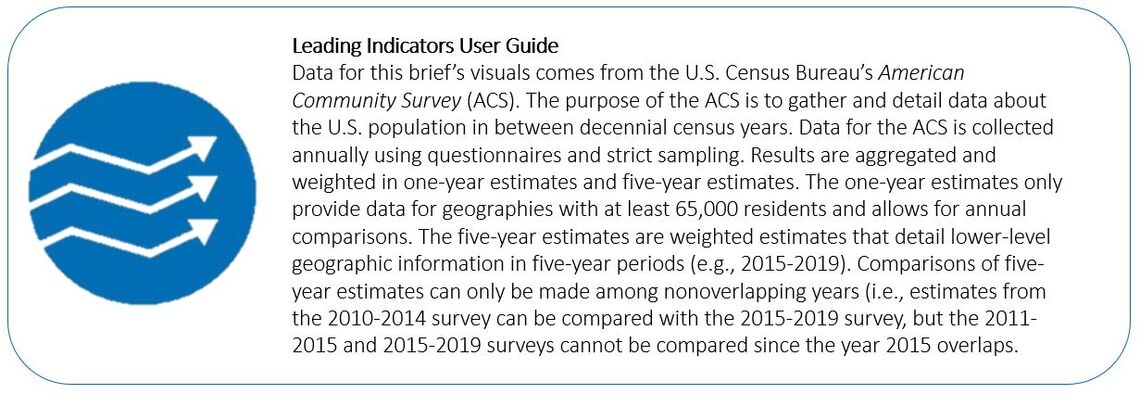The Changing Distribution of Poverty in Philadelphia
In its last session of 2020, Philadelphia's City Council passed legislation aligned with its Poverty Action Plan. Whether providing relief or job security for Black and brown service industry workers or restructuring the ten-year real estate tax abatement, many of these measures aim to lift Philadelphia families out of poverty. For our final Leading Indicator of 2020, we take a closer look at the concentration of poverty in Philadelphia and its growth and decline within city neighborhoods using the recently released 2019 estimates of the U.S. Census Bureau’s American Community Survey.
Key Takeaways
- In 2019, just under a quarter of Philadelphians were living in poverty, as defined by federal poverty thresholds.
- The percentage of Philadelphians living in poverty has been declining since 2011; 2019 saw the lowest percentage of residents living in poverty since 2005.
- Although they account for roughly 15.2 percent of Philadelphia’s population, 40.2 percent of Latinx Philadelphians were living in poverty in 2019 – a concentration 1.7 times greater than the city’s total concentration of impoverished residents and 5.2 times greater than the concentration of Non-Hispanic White impoverished residents.
- Poverty among the city’s Non-Hispanic Black population has been declining by an annual average rate of 1.2 percent between 2005 and 2019.
Poverty in Philadelphia
Philadelphia is the “poorest” of the largest U.S. cities, with 23.3 percent of residents living in poverty, surpassing the next largest poor U.S. city, Houston, by 2.9 percent [1]. Yet, as figure 1 shows, the percentage of Philadelphians living in poverty has been declining since 2011. In fact, 2019 saw the lowest percentage of residents living in poverty since 2005.
FIGURE 1
SOURCE: Data were obtained from one-year estimates of the U.S. Census Bureau’s 2005 thorugh 2019 American Community Survey.
While the overall proportion of Philadelphians living in poverty is decreasing, the distribution of impoverished residents is highly uneven. Figure 2 illustrates the distribution of impoverished Philadelphians by race and ethnicity from 2005 to 2019.
FIGURE 2
SOURCE: Data were obtained from one-year estimates of the U.S. Census Bureau’s 2005 through 2019 American Community Survey. Each racial category, except "White (Non-Hispanic)," includes residents of Latinx/Hispanic ethnicity.
Although they account for roughly 15.2 percent of Philadelphia’s population, 40.2 percent of Latinx Philadelphians were living in poverty in 2019 – a concentration 1.7 times greater than the city’s total concentration of impoverished residents, 1.5 times greater than the city’s Non-Hispanic Black population, and 5.2 times greater than the concentration of Non-Hispanic White impoverished residents. The concentration of poverty among Latinx residents has remained relatively stable from 2005 to 2019, growing on average by 0.1 percent per year.
Poverty has increased slightly for the city’s Non-Hispanic White, Asian, and Mixed-Race populations. From 2005 to 2019, each group saw an average annual growth in residential poverty by 1.2, 1.9, and 0.5 percent, respectively. Poverty among Philadelphia’s Black population has fallen slightly since 2005. While they represent roughly 40.1 percent of the city’s total residential population in 2019, 26.7 percent of the city’s Non-Hispanic Black population were living in poverty at the time. Since 2005, this rate has seen an annual average decline of 1.2 percent. The 2019 poverty rate for Non-Hispanic Black residents still outpaces the city’s average by 3.4 percent and is 14 percent greater than that of the Non-Hispanic White population.
The Neighborhood-Level Distribution of Poverty
Figure 3 illustrates the uneven geographic distribution of poverty using the difference in census tract poverty rates between the nonoverlapping five-year estimates of the 2014 and 2019 waves of the U.S. Census Bureau’s American Community Survey. Increases in poverty between 2014 and 2019, colored in orange and red, are largely concentrated in outlying Philadelphia neighborhoods.

FIGURE 3
SOURCE: Data were obtained from five-year estimates of the U.S. Census Bureau’s 2014 and 2019 American Community Surveys.
Many census tracts in Northeast Philadelphia, Germantown, Overbrook, Cobbs Creek, Southwest Philadelphia, and the lower sections of South Philadelphia saw significant increases in residential poverty between 2014 and 2019. Similarly, tracts surrounding major anchor institutions like the University of Pennsylvania, Drexel University, and Temple University also saw increases in poverty. While the statistics may reflect a large proportion of impoverished adults and families in these tracts surrounding anchor institutions, they may also be indicative of the large number of undergraduate and graduate student populations living in these tracts who either are unemployed or working part-time while they pursue their degrees.
Among the census tracts that saw the sharpest declines in residential poverty between 2014 and 2019 are those that are often colloquially identified as recently gentrified or gentrifying. Some examples include the Brewerytown, Sharswood, lower Cecil B. Moore, and East and West Kensington sections of North Philadelphia; the Spruce Hill, Walnut Hill, Cedar Park and West Powelton areas of West Philadelphia; and the Grays Ferry, Point Breeze, Hawthorne, Lower Pennsport, and Whitman areas of South Philadelphia. Yet the data also show decreases in poverty in neighborhoods often thought to be areas of historic and concentrated disinvestment, such as Glenwood, Fairhill, Juniata, and Belfield in North Philadelphia and Haddington and Parkside in West Philadelphia.
Improvement, but still a long way to go…
Poverty is a multidimensional phenomenon that extends beyond income. It affects all aspects of life including physical and mental health, familial relations, ability to find employment, and the social and economic fabric of their neighborhood. While this data brief shows that levels of poverty dropped between 2005 and 2019, the rate is still quite high and does not account for the recent economic upheaval wrought by the COVID-19 pandemic. Our Leading Indicators of 2020 detailed how the pandemic has been particularly detrimental to our region’s impoverished populations – especially poorer communities of color. We will continue to monitor these data in the coming year.
Works Cited
[1] U.S. Census Bureau. 2020. 2015-2019 American Community Survey 5-Year Estimates. Retrieved from: (https://www.census.gov/data.html).